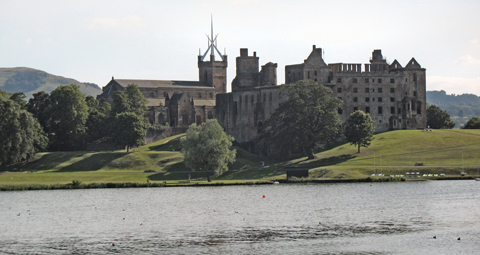September 15 | ![]() 0 COMMENTS
0 COMMENTS ![]() print
print

ROSS AHLFELD sets out on a dual destination pilgrimage in the footsteps of an archangel who was a defender of the Church and staunch enemy of Satan. - BY ROSS AHLFELD
This month’s pilgrimage is what you might describe as a ‘dual destination journey,’ kind of like those long holidays some people go on to Las Vegas and then Barbados (except, I haven’t been to either). No, even better than Vegas or Barbados, this month I visited both Bute and Linlithgow in search of St Michael the Archangel.
While a journey across the central belt from a small industrial town outside Edinburgh to a Clyde coast seaside town might not have the glamour or appeal of a pilgrimage to Mont-Saint-Michel in France or the sanctuary of Monte Sant’Angelo in Italy, I believe that the same spiritual journey can take place here, if we are willing to seek it out.
My first trip was a jaunt to historic Linlithgow. The town is home to the picturesque Linlithgow Palace, best known for being Mary Queen of Scots’ birthplace and one of the principle residencies of the Stewart Monarchs from James I to V.
As such, where there are Scottish kings and castles there are always signs to be found (somewhere nearby) of a once great devotion to our great saint and guardian St Michael the Archangel.
Unsurprisingly then, Linlithgow has two churches, both Catholic and Protestant, each named in honour of St Michael. In fact, the current Church of Scotland, St Michael’s parish church, next to the palace, was once the original seat of the Catholic Church prior to the Reformation.
Linlithgow has a strong history of Catholicism and St Michael has been associated with the town since at least the 13th century. Even Linlithgow’s industrial history points to its Catholic past. St Magdalene distillery at the Union Canal for example, produced single malt whisky from 1798 to 1983.
It’s thought that before the distillery existed, the site was home to a leper colony and a convent in the 12th century. The distillery took its name from St Magdalene’s convent which once stood upon the site.
St Michael’s Catholic Church in the east end of the town is not far from the banks of Linlithgow loch near the palace. Like my last pilgrimage to St Godric’s in Durham, St Michael’s is yet another beautiful Pugin designed Gothic Revival church from the Victorian era. The church also contains some beautiful modern stained glass windows.
From St Michael’s, it’s a short walk to the palace and Prestonfield Park, home to the famous Linlithgow Rose FC—also worth a visit. The ‘Rosey Posey’ is one of the oldest, biggest and most successful junior football teams in Scotland.
Before heading home, there was even time to call in at the ‘Four Marys’ pub for a quick pint.
Next, it was a trip ‘Doon the Watter’ to another castle and church associated with the archangel: the ruins of St Michael’s chapel within the walls of Rothesay Castle on the Isle of Bute. Like Linlithgow Palace, Rothesay Castle also has a long association with the Royal Stewarts. In addition to this, there are the remains of another medieval chapel dedicated to St Michael on Bute. ‘Kilmichael’ is located in the beautiful and remote part of north of Bute.
Interestingly, there is also a chapel of St Michael and All Angels next to the ruins of Inverkip Castle directly across the Clyde from Bute.
This chapel is also associated with another branch of the Royal Stewarts (the Shaw Stewart Baronets) but sadly this 19th century gothic chapel has been allowed to fall into a state of disrepair.
However, the main purpose of this particular pilgrimage was to visit the ancient ruins of St Blane’s Chapel and Monastery. I arrived on Bute in the morning and had time for Mass at St Andrew’s Church in Rothesay before heading round to Kilchattan Bay. I was made very welcome by the good folks at St Andrew’s and I was delighted to join the parishioners for morning prayers before Mass.
There’s something distinctive about churches around Argyll and the Isles. Despite being only an hour from Glasgow and just a short stretch across the Firth of Clyde from Paisley Diocese, the Isle of Bute feels somewhat different from my own parish.
Maybe it’s the cold light glinting onto simple stonework of churches in the Highlands and Islands, making each one of them feel like mini St Magnus Cathedrals. Or perhaps it’s a subconscious memory of a Catholic Faith forged by the Norse and Gaeldom.
Even so, the familiar rhythm of morning prayers is always the same. Catholic workers always start the day with Lauds at our ‘Place of Welcome’ in the heart of the city centre just as the faithful on Bute begin the day with morning prayers too.
As an Inverclyder at Mass in Argyll and the Isles, there is a sudden burst of novelty and excitement during the intercessory prayers when we hear the words: “And we pray also for our Bishop Brian.” At which point I’m forced to stifle the strong temptation to shout out—“Wooh! Yeah! He sure is the bishop!” For those who don’t know, Bishop Brian McGee is a native of Greenock and so it is a great source of pride down my way to have one of our own as the Bishop of Argyll and the Isles.
Before heading round to St Blane’s, I stopped by another building, prompting me to reflect on the words of the Kievan Rus: “We no longer knew whether we were in heaven or on earth.” No, I hadn’t stumbled upon the Divine Liturgy being celebrated in the Hagia Sophia. Rather, I was in the Victorian toilets at Rothesay pier.
As toilets go, these ones are pretty impressive, if you get the chance, check out the decorative tile work and marble finish.
Truthfully these toilets are worth a pilgrimage of their own, and so the bar had been set very high for this pilgrimage and I hadn’t even left the pier yet.
Another property associated with our Catholic Faith on Bute is the opulent Mount Stuart House, seat of the Marquesses of Bute who have been Catholic since the third Marquis. I wanted to see the little Marble Chapel, and it is indeed quite beautiful.
However, the big house itself is a bizarre mix of Catholic imagery alongside other occult, zodiac symbolism.
I appreciate very many Scottish Catholics adore Mount Stuart but for me it’s just too much, like a cross between Saddam’s palace and Trump’s penthouse. To be honest, the Victorian toilets back at Rothesay pier were less over the top.
In my trusty guide book Days at the Coast, Hugh MacDonald describes finding the ruins of St Blane’s chapel as being ‘in their own sweet solitude, a more lovely and secluded spot is difficult to imagine.’
Mr MacDonald goes on to convey an image of the old churchyard where ‘Catholic and Protestant, Templar and civilian, male and female, sleep soundly together in this quiet little churchyard as if in life, no division or strife had ever been encouraged amongst them.’
I’m sure Mr Macdonald would be pleased to know that 150 years later, Christians on Bute gather at St Blane’s for an annual summer ecumenical service, which this year was led by Ronald Campbell, the diocesan seminarian.
On the other hand, it’s worth noting that St Blane’s was consecrated with soil brought from Rome. Just as the ‘Celtic saints’ Ninian, Blane, Fillan, Modan and Catan all point back to one place: Rome.
I point this out because both early Celtic saints and the angels such as St Michael have, in recent times, been misappropriated by various mediums, pantheists and new agers.
They seek to link our holy angels and ‘Celtic Christianity’ to all sorts of clairvoyance, divination, astrology and spiritualism, even more so than the architecture at Mount Stuart
More so, they often like to re-imagine the angels and Celtic Christianity as being part of some kind of syncretism, mixing paganism with Christianity.
In reality, holding the Crucifix and the Rosary alongside dream catchers and healing crystals causes each belief to devalue the other, eventually turning each belief into a big ball of meaningless mush. Or in the words of Alabama 3 playing on my iPod on the long path up to St Blane’s: “Shut down my chakras, shift Shiva off my shelf, take down my tie dyes, my Tibetan bells, I ain’t going to Goa.”
Equally, it seems St Blane’s remained entirely orthodox to the end: Fr James McWaraty, the last parish priest at St Blane’s, refused to accept the Reformation and leave his parish.
Just as the well known and courageous Ninian Winzet at Linlithgow also resisted and stayed true to the Faith, for me both Bute and Linlithgow are symbolic of places where our ‘haly Catholik Kirk’ stayed strong until it had to be ripped from the faithful rather than given up.
Yet, what both places also share is the fact that the Faith has been miraculously restored and is alive again in Bute and Linlithgow today. Not in the medieval ruins or in the grounds of grand stately homes but in the living parish communities of St Michael’s and St Andrew where Masses are being celebrated again.
Among all the doom and gloom, it’s very easy to overlook the great joy of Holy Mass being celebrated daily in our ordinary parishes. And so, this Michaelmas, let’s reclaim our saint and put on the Scapular of St Michael the Archangel.
Let us say the novena to Michael, pray the chaplet of St Michael the Archangel and consecrate our homes to St Michael, just as Pope Francis has consecrated the Vatican City to the Archangel. After all, he is the patron saint of the Church. Maybe this explains why, when our devotion St Michael was strong, our Church was strong too. Likewise, when we were under the patronage of St Michael, our nation thrived.
Perhaps it will again one day, but for now let’s give thanks for the Masses which are being said today from Linlithgow to










